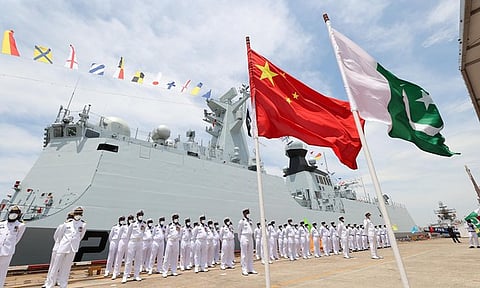
- Home
- न्यूजग्राम
- NewsGram USA
- India
- World
- Politics
- Entertainment
- Culture
- Lifestyle
- Economy
- Sports
- Sp. Coverage
- Misc.
- NewsGram Exclusive
- Jobs / Internships

China and Pakistan kicked off a four-day joint maritime exercise on Sunday in an effort to bolster their naval cooperation, which some analysts see as a cause of concern for India. China’s People’s Liberation Army Navy (PLAN) sent a submarine, three warships and four aircraft to the Sea Guardians-2 drills off Shanghai, the PLA Daily said. PLAN spokesperson Liu Wensheng was quoted by Chinese media as saying that the exercise was “arranged according to the annual military cooperation plan of the two navies, has nothing to do with the regional situation and is not targeted at any third party.”
Participating ships from the PLA Eastern Theatre Command include the guided-missile frigates Xiangtan and Shuozhou, the comprehensive supply ship Qiandaohu and one submarine. There is also one early warning aircraft, two fighter jets and a helicopter. Pakistan sent the frigate Taimur, the second of four powerful Type 054A/P ships built by China for Pakistan’s navy. The PLA said the joint maritime exercise aimed to “push forward development of the China-Pakistan all-weather strategic partnership of cooperation.” It will feature training courses including joint strikes against maritime targets, joint tactical maneuvering, joint anti-submarine warfare and joint support for damaged vessels.
Gaining momentum
The drills follow last month’s visit to China by Pakistan’s Chief of Army Staff, Gen. Qamar Javed Bajwa. During the trip, Gen. Javed Bajwa held talks with Zhang Youxia, one of China’s top generals and Vice Chairman of the Central Military Commission.
“Naval cooperation between China and Pakistan has been going on for quite some time but is gaining momentum now,” said Sana Hashmi, an Indian analyst and currently Visiting Fellow at the Taiwan-Asia Exchange Foundation in Taipei.
“This exercise in particular is being noticed in India as China’s reach in the IOR [Indian Ocean Region] will be bolstered with Pakistan’s assistance. Definitely a cause of concern for India,” she said. Indian media reported that Sino-Pakistan military cooperation in recent years focused more on navies as “China gradually stepped up its naval presence in India's backyard, the Indian Ocean.”
The current event is the second Sea Guardians exercise, the first was held in January 2020 in the North Arabian Sea. The Press Trust of India (PTI) said the Arabian Sea is strategically important as many major Indian ports are located there and it provides entry to the Indian Ocean where China recently built a logistics base at Djibouti in the Horn of Africa. Beijing has also acquired the operational control of Pakistan's Gwadar port in the Arabian Sea, which connects with China's Xinjiang province by land as part of the U.S.$60-billion China Pakistan Economic Corridor (CPEC). Further to that, it obtained a 99-year lease of Sri Lanka’s second largest port, Hambantota and is developing it as part of the ambitious Belt and Road Initiative.
“CPEC exists primarily to extend and strengthen China’s reach to the IOR and that’s one of the reasons besides the sovereignty issues that India opposes CPEC,” said Hashmi, adding that the Sino-Pakistan growing ties “will further bolster the Quad and encourage them to strengthen maritime cooperation.”
The Quad, or Quadrilateral Security Dialogue, is a strategic security dialogue between Australia, India, Japan, and the United States. Beijing has been slamming it, saying that the group represents an attempt to form an “Asian NATO.” Quad countries have repeatedly rejected the criticism. The Pakistan Navy ordered four powerful Type 054A/P frigates from China in 2017, two of which were delivered this year. It also signed a multi-billion deal to acquire eight submarines from China by 2028.
